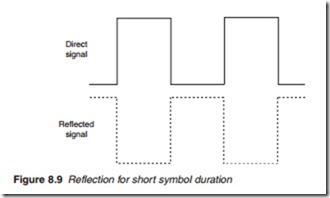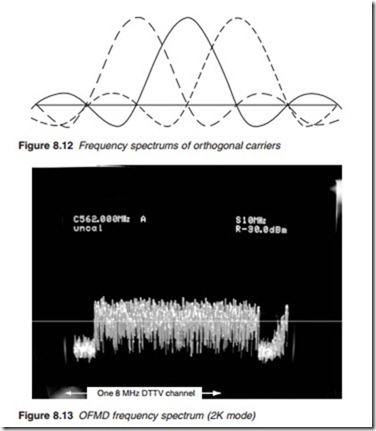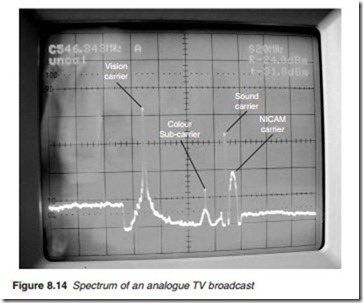Orthogonal frequency division multiplexing
QAM encoding is very effective and very efficient. However, unlike satellite transmission, terrestrial broadcasting suffers from multiple path interference. In terrestrial transmission, besides the direct signal from the transmit- ter, a receiving aerial may receive one or more signals that have been
reflected off buildings, trees or moving objects such as flying airplanes. Reflected signals take a longer time to reach the receiving aerial than direct signals. In analogue TV transmission, the delayed signal will cause another faded picture to appear on the screen, known as a ghost. In DTV transmis- sion, delayed signals can cause intersymbol interference and fading, which may result in partial or full picture and sound break-up depending on the amount of delay. If the delay results in a phase delay of 180°, the reflected signal cancels out the direct signal and complete picture and sound failure occurs (Figure 8.9). This can be avoided by using OFDM.
OFDM involves the distribution of a high-rate serial bitstream over a large number of parallel carriers. For each carrier, the bit rate is far below that of the original modulating bitstream. The carriers, 2048 (2K mode) or 8192 (8K mode), are closely and precisely spaced across the available band- width. Each carrier is modulated (PSK, 16-QAM or 64-QAM) simultaneously at regular intervals with the set of data bits used to modulate the carriers known as the OFDM symbol. Due to the large number of carriers, the duration of the OFDM symbol is considerably larger than the duration of one bit of the modulating bitstream. Consider a bitstream consisting of 1000 bits, with bit duration of 0.1 f.s. If the 1000 bits are used to modulate a single carrier (simple PSK), the duration over which each bit remains ‘active’, i.e. the symbol duration, is 0.1 f.s. If, on the other hand, the 1000 bits are used to modulate 500 carriers to form an OFDM symbol, the duration of the OFDM symbol will be 2 X 0.1 X 1000 = 50 f.s. With a few thousand carriers and a more efficient modulation, e.g. 6-QAM, the symbol duration could be a few hundred times longer than the duration of the bits in the original bitstream.
With long symbol duration, a reflected signal will only be out of phase with the direct signal for a part of the total duration, shown shaded in Figure 8.10. For the rest of the symbol duration, the reflected signal is actively supporting the direct path signal. To avoid the shaded area, a guard interval (also known as a guard period) is added at the start of the
symbol during which time the receiver pauses before starting the evaluation of the carriers.
The total symbol duration thus consists of two parts: a useful duration tu proceeded by a guard period set to a fraction of the useful duration, e.g. tu/4, tu/8, tu/16. For instance, employing the 8K mode, the useful symbol duration is set to 896 f.s. Using a guard period tu/4 would protect against echoes with delays as large as 224 f.s. The introduction of a guard period, however, reduces the number of active carriers available for modulation and hence lowers the data capacity of the system. In the UK, the number of carriers used is 2048 but the number of active carriers is only 1705.
In OFDM, the carriers are harmonically related with a common and pre- cisely calculated frequency spacing to ensure orthogonality (Figure 8.11). The spacing is set to the reciprocal of the symbol duration tu:
By ensuring orthogonality of the carriers, the demodulator of one carrier is not made aware of the existence of the other carriers, thus avoiding crosstalk. Figure 8.12 shows the effect of orthogonality in which the fun- damental frequency of one carrier which, being a sine wave, is the only frequency component, occurs when adjacent carriers spectrums crosses the zero line.
When all the carriers are included, a flat spectrum is obtained (Figure 8.13); this is designed to occupy the same bandwidth as allocated to a con- ventional analogue television programme, namely 8 MHz for the UK and 6 MHz for the USA.
The flat spectrum of OFDM reduces the effective radiated power (ERP) required of the digital terrestrial television (DTTV) transmitter compared
with analogue terrestrial broadcasting, in which the carrier power is con- centrated in narrow bands around the vision carrier, colour sub-carrier, FM sound and NICAM carriers (Figure 8.14). In contrast, DTTV transmit- ted power is more evenly and efficiently spread across the whole spec- trum, giving considerable savings in power as shown in Figure 8.15. The complete standard definition terrestrial transmission from Crystal Palace is shown in Figure 8.16. It will be noticed that the digital multiplexes are 15–20 dB below the analogue TV broadcasts. This is necessary while both systems cohabit the same UHF band with adjacent channels to avoid cross-interference. However, when analogue is switched off, this restriction will no longer be necessary. Digital terrestrial broadcasts power may thus be increased making it possible for good un-interrupted reception using a simple indoor aerial.



